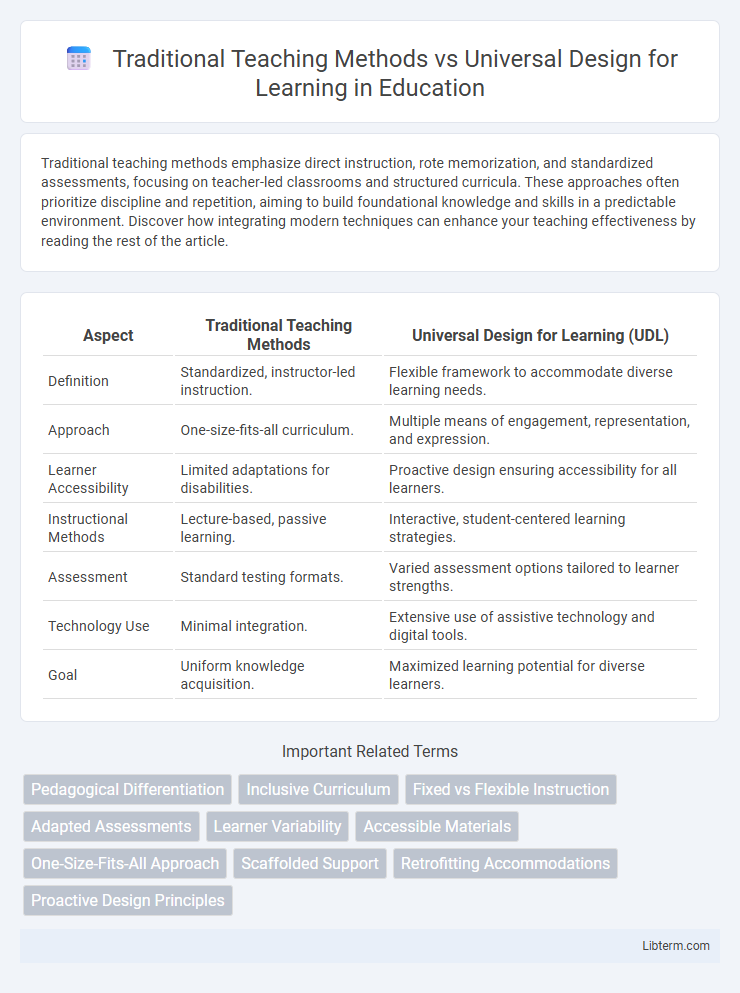Traditional teaching methods emphasize direct instruction, rote memorization, and standardized assessments, focusing on teacher-led classrooms and structured curricula. These approaches often prioritize discipline and repetition, aiming to build foundational knowledge and skills in a predictable environment. Discover how integrating modern techniques can enhance your teaching effectiveness by reading the rest of the article.
Table of Comparison
| Aspect | Traditional Teaching Methods | Universal Design for Learning (UDL) |
|---|---|---|
| Definition | Standardized, instructor-led instruction. | Flexible framework to accommodate diverse learning needs. |
| Approach | One-size-fits-all curriculum. | Multiple means of engagement, representation, and expression. |
| Learner Accessibility | Limited adaptations for disabilities. | Proactive design ensuring accessibility for all learners. |
| Instructional Methods | Lecture-based, passive learning. | Interactive, student-centered learning strategies. |
| Assessment | Standard testing formats. | Varied assessment options tailored to learner strengths. |
| Technology Use | Minimal integration. | Extensive use of assistive technology and digital tools. |
| Goal | Uniform knowledge acquisition. | Maximized learning potential for diverse learners. |
Introduction to Teaching Methodologies
Traditional teaching methods predominantly rely on teacher-centered instruction, emphasizing direct lectures, rote memorization, and standardized assessments, which may not address diverse student needs. Universal Design for Learning (UDL) introduces a flexible framework that incorporates multiple means of representation, engagement, and expression to accommodate varied learning preferences and abilities. Integrating UDL principles enhances inclusivity and accessibility by promoting personalized learning pathways within the teaching methodology landscape.
Defining Traditional Teaching Methods
Traditional teaching methods emphasize teacher-centered instruction, relying heavily on lectures, rote memorization, and standardized assessments to deliver content uniformly to all students. These methods often prioritize a fixed curriculum and passive learning, where students receive information without significant opportunities for engagement or differentiation. Limited flexibility in addressing diverse learning styles and needs characterizes traditional education approaches.
Understanding Universal Design for Learning (UDL)
Universal Design for Learning (UDL) is an educational framework that promotes flexible learning environments to accommodate diverse student needs and learning styles. Unlike traditional teaching methods that often rely on a one-size-fits-all approach, UDL emphasizes multiple means of representation, engagement, and expression, ensuring all students have equal opportunities to succeed. By integrating technology and varied instructional strategies, UDL enhances accessibility and comprehension for learners with different abilities and preferences.
Core Principles of Traditional Approaches
Traditional teaching methods primarily emphasize direct instruction, teacher-centered classrooms, and standardized assessments to evaluate student performance. These approaches often rely on uniformity in content delivery, repetitive practice, and memorization to reinforce learning objectives. Core principles include a structured curriculum, clear expectations, and a focus on mastery of specific academic skills within a controlled environment.
Key Concepts of Universal Design for Learning
Universal Design for Learning (UDL) centers on providing multiple means of engagement, representation, and action/expression to accommodate diverse learners and promote inclusive education. Unlike traditional teaching methods that often rely on a one-size-fits-all approach, UDL emphasizes flexibility and accessibility by integrating varied instructional materials and assessment options. Key concepts include proactive design, personalized learning pathways, and the reduction of barriers to foster equitable participation and achievement for all students.
Comparing Classroom Implementation
Traditional teaching methods often rely on a teacher-centered approach with fixed curriculum and uniform pacing, which may limit engagement for diverse learners. Universal Design for Learning (UDL) emphasizes flexible curriculum design, offering multiple means of representation, engagement, and expression to accommodate varied learning styles and abilities. In classroom implementation, UDL fosters inclusive environments by integrating technology, adjustable assessments, and personalized learning paths, enhancing accessibility compared to the one-size-fits-all model typical of traditional methods.
Student Engagement: Traditional vs UDL
Traditional teaching methods often rely on lecture-based instruction and standardized assessments, which can limit student engagement by failing to address diverse learning styles and needs. Universal Design for Learning (UDL) enhances student engagement by providing multiple means of representation, expression, and engagement tailored to individual preferences and abilities. Research indicates that UDL strategies significantly improve participation, motivation, and comprehension compared to traditional approaches.
Accessibility and Inclusivity in Both Methods
Traditional teaching methods often rely on uniform instructional approaches that may hinder accessibility for diverse learners, limiting inclusivity in the classroom. Universal Design for Learning (UDL) prioritizes accessibility by offering multiple means of representation, engagement, and expression, ensuring all students, including those with disabilities, can access and participate in the curriculum. UDL's flexible strategies enhance inclusivity by addressing varied learning needs and reducing barriers to education.
Outcomes and Benefits for Learners
Traditional teaching methods often rely on uniform instruction and assessment, which may not address diverse learner needs, leading to varied academic outcomes. Universal Design for Learning (UDL) enhances learner engagement and achievement by providing multiple means of representation, expression, and engagement tailored to individual strengths. The UDL framework supports higher retention rates, improved motivation, and equitable access to education for all students, including those with disabilities.
Choosing the Right Approach for Modern Classrooms
Traditional teaching methods often rely on a one-size-fits-all approach, emphasizing direct instruction and standardized assessments that may not address diverse student needs. Universal Design for Learning (UDL) promotes flexible learning environments with multiple means of representation, engagement, and expression to support inclusivity and accessibility. Selecting the right approach in modern classrooms involves balancing structured guidance with adaptive strategies to enhance student engagement, retention, and personalized learning outcomes.
Traditional Teaching Methods Infographic

 libterm.com
libterm.com